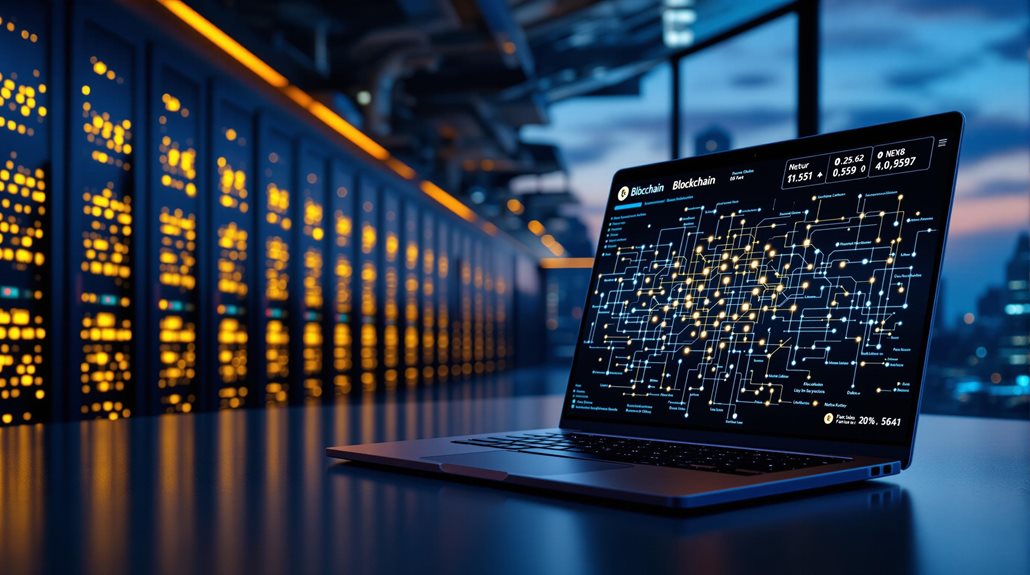Cryptocurrency works as a digital money system that doesn't need banks or governments. It uses special computer networks called blockchains to record and verify transactions. Users need digital wallets with public and private keys to send and receive funds. The system relies on miners who validate transactions by solving complex math problems. These transactions get added to the blockchain permanently. Understanding the different types of wallets and verification methods reveals cryptocurrency's full potential.

Cryptocurrency powers a revolutionary digital payment system that operates without banks or governments. It uses a technology called blockchain, which is like a digital ledger that keeps track of every transaction. This ledger isn't stored in one place – it's spread across many computers around the world, making it nearly impossible to hack or manipulate. Bitcoin has recently reached a milestone as its price touched one hundred thousand dollars for the first time.
When someone wants to send cryptocurrency to another person, they'll need a special piece of software called a wallet. The wallet holds two important keys: a public key, which works like an email address where you can receive funds, and a private key, which is like a password that lets you send funds. It's essential to keep the private key secret, as anyone who has it can access the cryptocurrency. Payment processors like BitPay provide users with simplified transaction initiation for businesses.
There are two main types of wallets: hot wallets and cold wallets. Hot wallets are connected to the internet, making them convenient for frequent trading but more vulnerable to hacking. Cold wallets are offline storage devices that offer better security but aren't as easy to use for quick transactions. In September 2023, there were approximately 635,000 daily transactions occurring on the Bitcoin network alone.
When someone sends cryptocurrency, the transaction gets broadcast to a network of computers. These computers, called nodes, check if the transaction is valid. Special participants called miners (or validators in some cryptocurrencies) then group multiple transactions into blocks and add them to the blockchain. They're rewarded with new cryptocurrency and transaction fees for their work. The consensus mechanism ensures all network participants agree on the validity of each transaction before it's permanently recorded.
Different cryptocurrencies use different methods to verify transactions. Bitcoin, for example, uses a system called Proof of Work, where miners solve complex mathematical puzzles. This process uses a lot of energy but keeps the network secure. Other cryptocurrencies use Proof of Stake, where people put up their own cryptocurrency as collateral to verify transactions, which uses less energy.
Once a transaction is confirmed and added to the blockchain, it can't be reversed. The system automatically adjusts how difficult it is to mine new blocks to keep transaction times consistent. This whole process typically happens faster and costs less than traditional bank transfers.
The technology's decentralized nature means no single entity controls the network, and anyone can participate in maintaining it. This makes cryptocurrency a unique form of digital money that's changing how people think about financial transactions.
Frequently Asked Questions
Can Cryptocurrency Transactions Be Traced Back to Specific Individuals?
Yes, crypto transactions can often be traced to specific people.
While cryptocurrencies provide some privacy through pseudonymous addresses, they're not completely anonymous.
Law enforcement can track transactions on public blockchains and work with exchanges that collect customer information. They use special tools to analyze transaction patterns and cluster related addresses.
However, privacy coins and mixing services can make tracing more difficult.
What Happens to My Cryptocurrency if I Lose My Digital Wallet?
When someone loses their digital wallet, their cryptocurrency isn't actually gone – it's still on the blockchain.
However, without the wallet's private keys or seed phrase, they can't access their funds. It's like losing the only key to a safe.
The funds remain permanently locked and inaccessible. There's no customer service to call or password reset option.
The coins stay frozen forever, effectively removed from circulation.
How Long Does It Take to Mine One Bitcoin?
Mining one Bitcoin isn't a fixed timeframe. It depends on the miner's equipment and the network's total mining power.
With a powerful ASIC miner (390 TH/s), it would take about 3,543 days to mine one Bitcoin alone.
The entire Bitcoin network mines 3.125 BTC every 10 minutes, but that's split among all miners worldwide.
Most miners join mining pools to earn smaller, more frequent shares of Bitcoin instead of waiting years.
Why Do Cryptocurrency Prices Fluctuate so Dramatically?
Cryptocurrency prices swing wildly due to several key factors. The limited supply of coins means even small changes in demand can cause big price moves.
When lots of people buy at once, prices shoot up fast. When they sell, prices drop quickly.
News about regulations, security issues, or famous people's tweets can change how investors feel about crypto.
Unlike stocks, crypto markets run 24/7, which adds to their volatility.
Is Cryptocurrency Mining Harmful to the Environment?
Cryptocurrency mining has significant environmental impacts. It uses as much electricity annually as entire countries like Argentina and the Netherlands.
A single Bitcoin transaction creates the same carbon footprint as 800,000 Visa transactions. Mining operations contribute to global warming through massive CO2 emissions and require substantial water resources.
The process also needs large land areas for mining facilities and power generation, affecting local ecosystems and communities.





